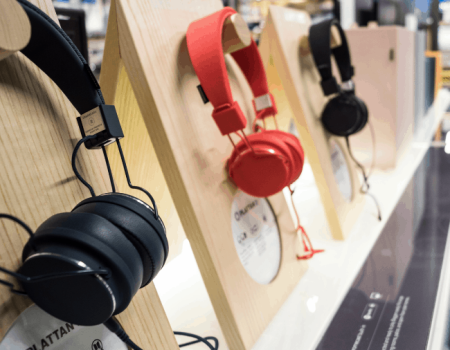The Electronics Industry
DOES OMNICHANNEL LEAD TO GOOD FINANCIAL PERFORMANCE?
This year, Danske Bank has provided a financial analysis of the Omnichannel Index’s industries to get a deeper understanding of each industry’s terms.
Presented in collaboration with
Solid financial performance

best of the best
The electronics industry is without doubt the best omnichannel industry.
But the retailers and brands in the industry have difficult terms with a tough fight for customers.
For a long period of time, the industry has decreased its earnings by price matching, which has resulted in varying ability to generate positive profit. Fortunately, the industry’s revenue growth in the Nordics is strong.
Average score of all industries
Average score of the electronics industri
“The industry is known for cost-conscious customers and many companies now focus on increasing customer experience and optimizing its store network,” Jesper Langborg Jensen, Head of Business Advisory and insights at Danske Bank.
In total, the purchase of electronic products account for 10% of the private consumption in Denmark, according to FDIH, and it is the industry with the highest order value.
The results across nations
DK: 60
SE: 60
NO: 46
DK: 55
SE: 66
NO: 65
DK: 56
SE: 48
NO: 49
DK: 38
SE: 45
NO: 52
DK: 57
SE: 30
NO: 54
POST COVID-19 CUSTOMERS
Unfortunately, many retailers in the industry do not take advantage of their full potential. By comparing the omnichannel score with financial insights, only a few have a strong annual growth rate and high omnichannel scores.
This leaves the playing field open to digital competitors, especially since 23% of customers expect to buy more electronic products online as a consequence of the COVID-19 crisis.
“Many electronics retailers and brands are excellent at omnichannel, but the competition within the industry is fierce and earnings are under significant pressure,” explains Jesper Langborg Jensen, Head of Business Advisory and insights at Danske Bank.
Don’t forget the post-purchase
With varying profit, disloyal customers, and the same product range as competitors, the retailers must do something extra to retain the customers. And this extra lays in the post-purchase phase.
With loyalty programme and better use of customer data the industry can give the customers a more personal experience and upsell based on the customers buying historic.
This is something many electronics retailers neglect and that under half of the industry do not offer.
Delivery and updated stock
The electronics customers care more about the price than which retailer they buy from, and most of the retailers have identical product range. But electronic retailers must avoid the pitfall of competing solely on price.
Competing purely on costs is often not long term viable against global competitors.
One way the retailers can differentiate themselves is by offering fast delivery and make sure that they have the products in stock. This is one of the most important competitions parameters for the industry.
“We know that Amazon has a strong position in the electronic market, and they are known for fast delivery. And with Amazon’s coming soon, this will only be more important,” tells Kasper Holst, CEO of IMPACT.





